Oil Lexus CT200h 2013 Owner's Manual (in English)
[x] Cancel search | Manufacturer: LEXUS, Model Year: 2013, Model line: CT200h, Model: Lexus CT200h 2013Pages: 688
Page 8 of 688
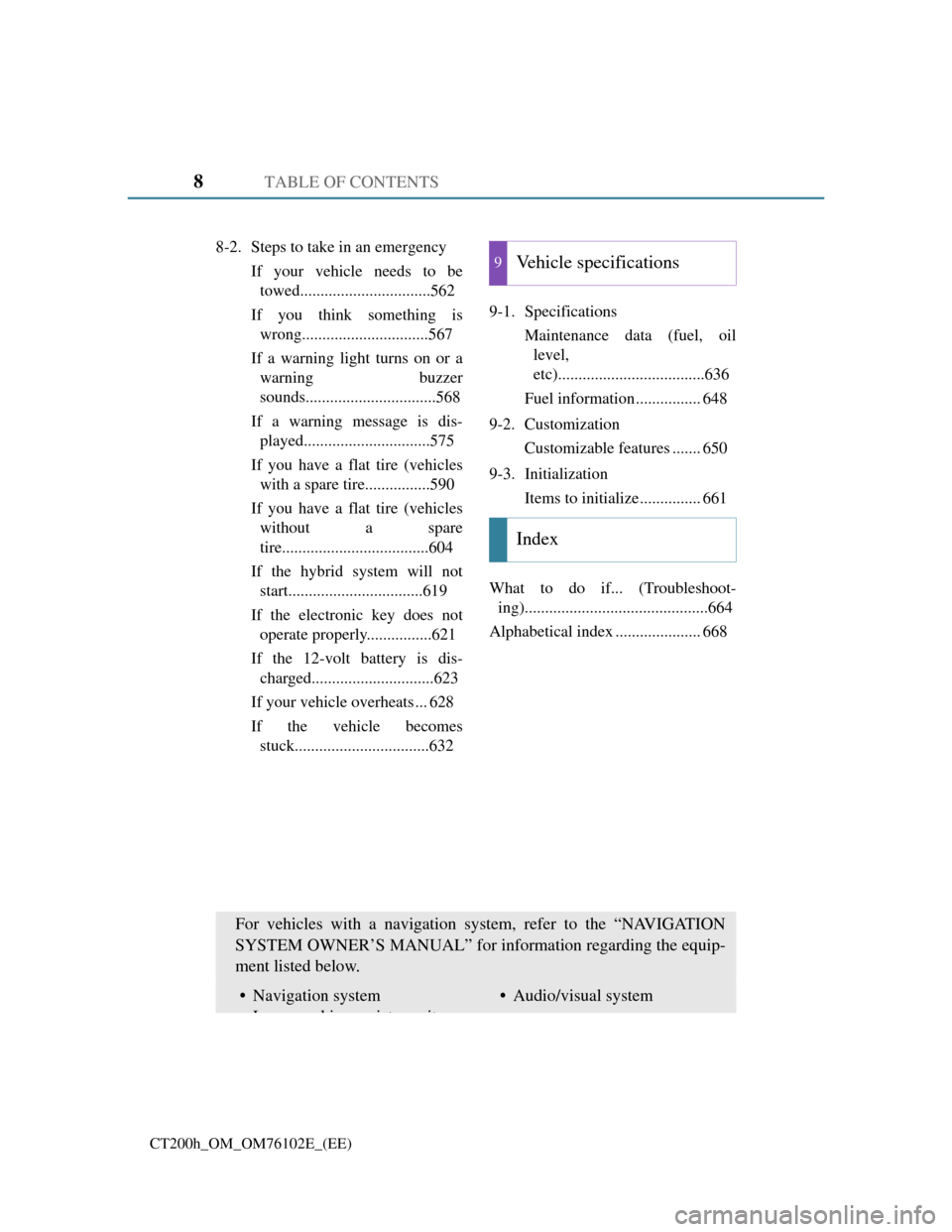
TABLE OF CONTENTS8
CT200h_OM_OM76102E_(EE)
8-2. Steps to take in an emergency
If your vehicle needs to be
towed................................562
If you think something is
wrong...............................567
If a warning light turns on or a
warning buzzer
sounds................................568
If a warning message is dis-
played...............................575
If you have a flat tire (vehicles
with a spare tire................590
If you have a flat tire (vehicles
without a spare
tire....................................604
If the hybrid system will not
start.................................619
If the electronic key does not
operate properly................621
If the 12-volt battery is dis-
charged..............................623
If your vehicle overheats ... 628
If the vehicle becomes
stuck.................................6329-1. Specifications
Maintenance data (fuel, oil
level,
etc)....................................636
Fuel information................ 648
9-2. Customization
Customizable features ....... 650
9-3. Initialization
Items to initialize............... 661
What to do if... (Troubleshoot-
ing).............................................664
Alphabetical index ..................... 6689Vehicle specifications
Index
For vehicles with a navigation system, refer to the “NAVIGATION
SYSTEM OWNER’S MANUAL” for information regarding the equip-
ment listed below.
• Navigation system
Lkiitit• Audio/visual system
Page 17 of 688
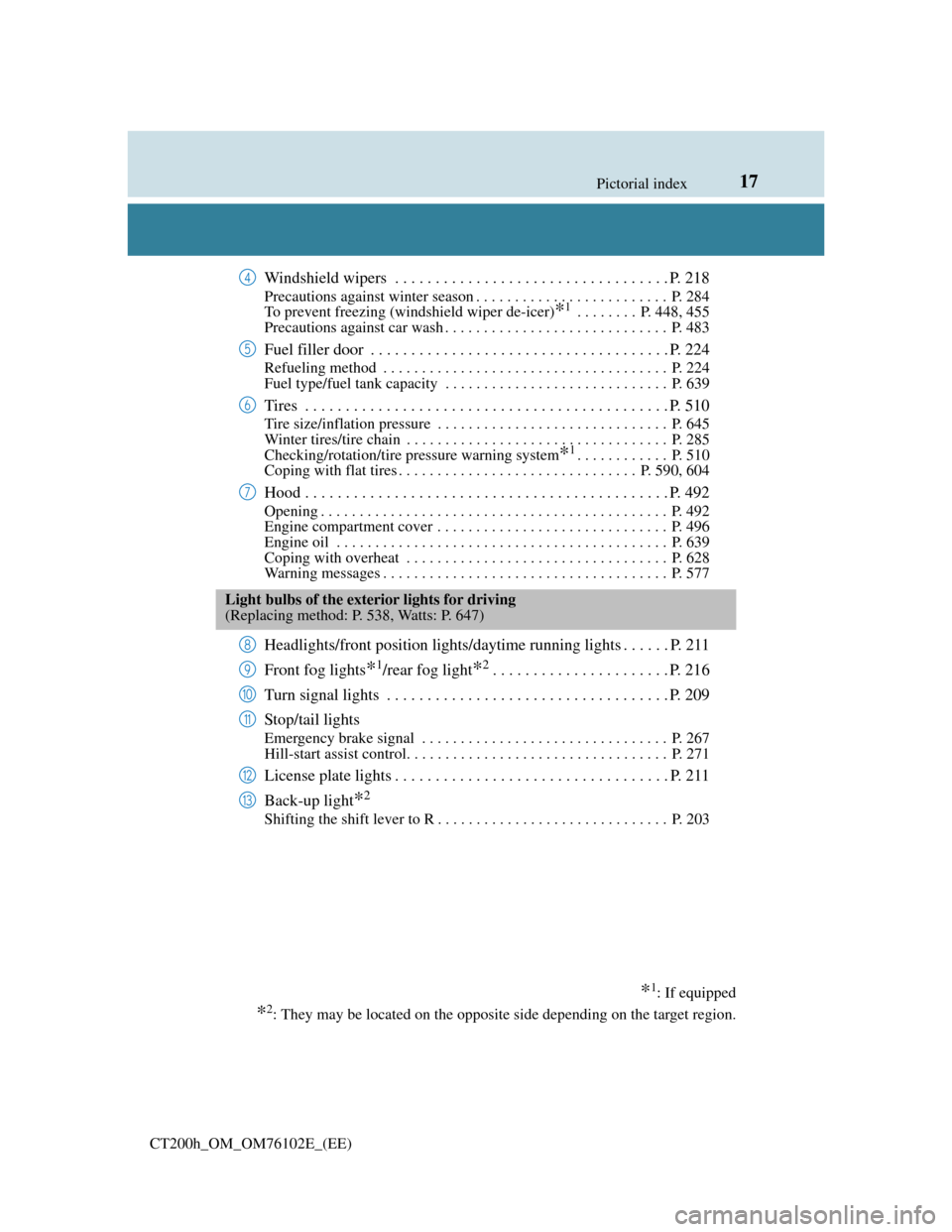
17Pictorial index
CT200h_OM_OM76102E_(EE)
Windshield wipers . . . . . . . . . . . . . . . . . . . . . . . . . . . . . . . . . . P. 218
Precautions against winter season . . . . . . . . . . . . . . . . . . . . . . . . . P. 284
To prevent freezing (windshield wiper de-icer)
*1 . . . . . . . . P. 448, 455
Precautions against car wash . . . . . . . . . . . . . . . . . . . . . . . . . . . . . P. 483
Fuel filler door . . . . . . . . . . . . . . . . . . . . . . . . . . . . . . . . . . . . . P. 224
Refueling method . . . . . . . . . . . . . . . . . . . . . . . . . . . . . . . . . . . . . P. 224
Fuel type/fuel tank capacity . . . . . . . . . . . . . . . . . . . . . . . . . . . . . P. 639
Tires . . . . . . . . . . . . . . . . . . . . . . . . . . . . . . . . . . . . . . . . . . . . . P. 510
Tire size/inflation pressure . . . . . . . . . . . . . . . . . . . . . . . . . . . . . . P. 645
Winter tires/tire chain . . . . . . . . . . . . . . . . . . . . . . . . . . . . . . . . . . P. 285
Checking/rotation/tire pressure warning system
*1. . . . . . . . . . . . P. 510
Coping with flat tires . . . . . . . . . . . . . . . . . . . . . . . . . . . . . . . P. 590, 604
Hood . . . . . . . . . . . . . . . . . . . . . . . . . . . . . . . . . . . . . . . . . . . . . P. 492
Opening . . . . . . . . . . . . . . . . . . . . . . . . . . . . . . . . . . . . . . . . . . . . . P. 492
Engine compartment cover . . . . . . . . . . . . . . . . . . . . . . . . . . . . . . P. 496
Engine oil . . . . . . . . . . . . . . . . . . . . . . . . . . . . . . . . . . . . . . . . . . . P. 639
Coping with overheat . . . . . . . . . . . . . . . . . . . . . . . . . . . . . . . . . . P. 628
Warning messages . . . . . . . . . . . . . . . . . . . . . . . . . . . . . . . . . . . . . P. 577
Headlights/front position lights/daytime running lights . . . . . . P. 211
Front fog lights
*1/rear fog light*2. . . . . . . . . . . . . . . . . . . . . . P. 216
Turn signal lights . . . . . . . . . . . . . . . . . . . . . . . . . . . . . . . . . . . P. 209
Stop/tail lights
Emergency brake signal . . . . . . . . . . . . . . . . . . . . . . . . . . . . . . . . P. 267
Hill-start assist control. . . . . . . . . . . . . . . . . . . . . . . . . . . . . . . . . . P. 271
License plate lights . . . . . . . . . . . . . . . . . . . . . . . . . . . . . . . . . . P. 211
Back-up light
*2
Shifting the shift lever to R . . . . . . . . . . . . . . . . . . . . . . . . . . . . . . P. 203
4
5
6
7
Light bulbs of the exterior lights for driving
(Replacing method: P. 538, Watts: P. 647)
*1: If equipped
*2: They may be located on the opposite side depending on the target region.
8
9
10
11
12
13
Page 101 of 688

1012. Instrument cluster
2
Instrument cluster
CT200h_OM_OM76102E_(EE)
Warning lights inform the driver of malfunctions in any of the vehicle’s
systems.
Warning lights
*1Brake system warning
light
(P. 568)*1Slip indicator light
(P. 570)
*1Brake system warning
light
(P. 568)*1
(if
equipped)
Automatic headlight
leveling system warning
light (P. 570)
*1Charging system warning
light (P. 568)*1High coolant temperature
warning light (P. 570)
*1Low engine oil pressure
warning light (P. 568)Open door warning light
(P. 570)
*1Malfunction indicator
lamp
(P. 569)Low fuel level warning
light
(P. 570)
*1SRS warning light
(P. 569)Driver’s and front
passenger’s seat belt
reminder light (P. 570)
*1ABS warning light
(P. 569)*3Rear passengers’
seat
belt reminder lights
(P. 570)
*1Electric power steering
system warning
light (P. 569)*1Master warning light
(P. 570)
*1, 2
(if
equipped)
“PCS” warning light
(P. 569)
*1
(if
equipped)
Tire pressure warning
light
(P. 571)
Page 145 of 688

1453-2. Opening, closing and locking the doors
3
Operation of each component
CT200h_OM_OM76102E_(EE)
Battery-saving function (vehicles with entry function)
The battery-saving function will be activated in order to prevent the electronic
key battery and the 12-volt battery from being discharged while the vehicle is not
in operation for a long time.
In the following situations, the smart entry & start system may take some time
to unlock the doors.
• The electronic key has been left in an area of approximately 2 m (6 ft.) of the
outside of the vehicle for 10 minutes or longer.
• The smart entry & start system has not been used for 5 days or longer.
If the smart entry & start system has not been used for 14 days or longer, the
doors cannot be unlocked at any doors except the driver’s door. In this case,
take hold of the driver’s door handle, or use the wireless remote control or the
mechanical key, to unlock the doors.
Conditions affecting operation
The smart entry & start system, wireless remote control and immobilizer system
use weak radio waves. In the following situations, the communication between
the electronic key and the vehicle may be affected, preventing the smart entry &
start system, wireless remote control and immobilizer system from operating
properly.
(Ways of coping: P. 621)
When the electronic key battery is depleted
Near a TV tower, electric power plant, gas station, radio station, large display,
airport or other facility that generates strong radio waves or electrical noise
When carrying a portable radio, cellular phone, cordless phone or other wire-
less communication devices
When the electronic key is in contact with, or is covered by the following
metallic objects
• Cards to which aluminum foil is attached
• Cigarette boxes that have aluminum foil inside
• Metallic wallets or bags
•Coins
• Hand warmers made of metal
• Media such as CDs and DVDs
When other wireless key (that emit radio waves) is being used nearby
When carrying the electronic key together with the following devices that emit
radio waves
• Another vehicle’s electronic key or a wireless key that emits radio waves
• Personal computers or personal digital assistants (PDAs)
• Digital audio players
• Portable game systems
If window tint with a metallic content or metallic objects are attached to the rear
window
Page 177 of 688

1773-4. Adjusting the steering wheels and mirrors
3
Operation of each component
CT200h_OM_OM76102E_(EE)
WA R N I N G
When driving the vehicle
Observe the following precautions while driving.
Failing to do so may result in loss of control of the vehicle and cause an acci-
dent, resulting in death or serious injury.
Do not adjust the mirrors while driving.
Do not drive with the mirrors folded.
Both the driver and passenger side mirrors must be extended and properly
adjusted before driving.
When a mirror is moving
To avoid personal injury and mirror malfunction, be careful not to get your
hand caught by the moving mirror.
When the mirror defoggers are operating
Do not touch the rear view mirror surfaces, as they can become very hot and
burn you.
NOTICE
Handling the rain clearing mirror (type B only)
The rain clearing effect is finite. Observe the Following precautions in order to
retain the rain-clearing properties of the mirrors:
When using water repellent, oil film remover, wax, or any other car mainte-
nance product that contains silicone, pay full attention not to adhere it to the
mirror surface.
Do not wipe the mirror surface by using any cloth smeared with sand, oil film
remover, abrasive agent, or any other thing that may scratch the mirror sur-
face.
When the mirrors become iced up, remove the ice by applying warm water, or
operating the outside rear view mirror defoggers, etc. But, do not attempt to
scrape the ice off by using the plastic plate, etc.
When washing your vehicle using car shampoo with water repellent effect,
rinse the mirror surface with a lot of water, and remove the water drops by
using a clean and soft cloth.
Page 193 of 688

1934-1. Before driving
4
Driving
CT200h_OM_OM76102E_(EE)
NOTICE
When driving the vehicle
Do not depress the accelerator and brake pedals at the same time during driv-
ing, as this may restrain driving torque.
Do not use the accelerator pedal or depress the accelerator and brake pedals at
the same time to hold the vehicle on a hill.
When parking the vehicle
Always shift the shift position to P. Failure to do so may cause the vehicle to
move or the vehicle may accelerate suddenly if the accelerator pedal is acciden-
tally depressed.
Avoiding damage to vehicle parts
Do not turn the steering wheel fully in either direction and hold it there for an
extended period of time.
Doing so may damage the power steering motor.
When driving over bumps in the road, drive as slowly as possible to avoid
damaging the wheels, underside of the vehicle, etc.
If you get a flat tire while driving
A flat or damaged tire may cause the following situations. Hold the steering
wheel firmly and gradually depress the brake pedal to slow down the vehicle.
It may be difficult to control your vehicle.
The vehicle will make abnormal sounds or vibrations.
The vehicle will lean abnormally.
Information on what to do in case of a flat tire (P. 590, 604)
When encountering flooded roads
Do not drive on a road that has flooded after heavy rain etc. Doing so may
cause the following serious damage to the vehicle:
Engine stalling
Short in electrical components
Engine damage caused by water immersion
In the event that you drive on a flooded road and the vehicle is flooded, be sure
to have any authorized Lexus dealer or repairer, or another duly qualified and
equipped professional check the following:
Brake function
Changes in quantity and quality of oil and fluid used for the engine, transmis-
sion, etc.
Lubricant condition for the bearings and suspension joints (where possible),
and the function of all joints, bearings, etc.
If the P position control system is damaged by flooding, it may not be possible
to shift the shift position to P, or from P to other positions. When the shift posi-
tion cannot be changed from P to any other position, the front wheels will lock,
and you will be unable to tow the vehicle with the front wheels on the ground,
as the front wheels may be locked. In this case, transport the vehicle with both
front wheels or all four wheels lifted.
Page 286 of 688
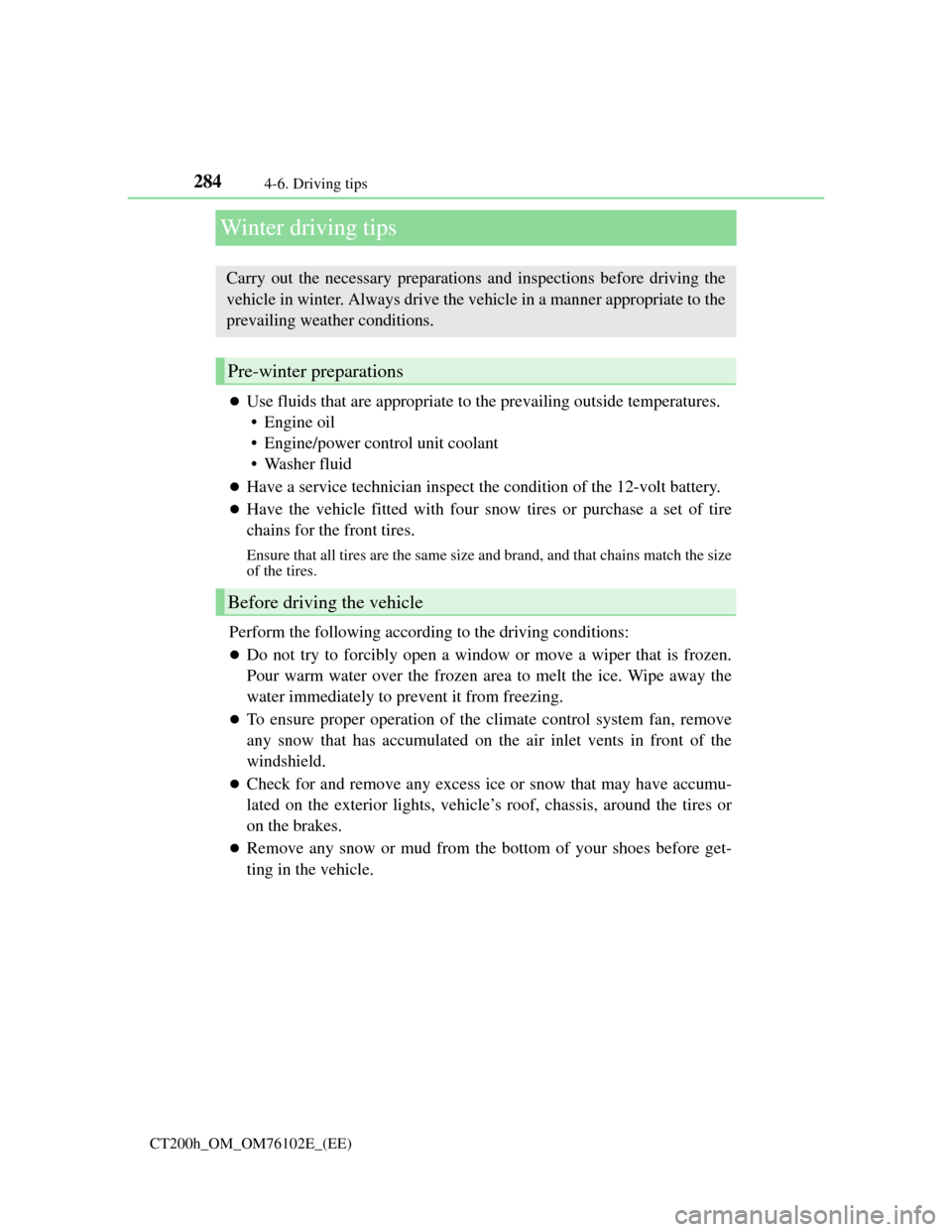
2844-6. Driving tips
CT200h_OM_OM76102E_(EE)
Winter driving tips
Use fluids that are appropriate to the prevailing outside temperatures.
•Engine oil
• Engine/power control unit coolant
•Washer fluid
Have a service technician inspect the condition of the 12-volt battery.
Have the vehicle fitted with four snow tires or purchase a set of tire
chains for the front tires.
Ensure that all tires are the same size and brand, and that chains match the size
of the tires.
Perform the following according to the driving conditions:
Do not try to forcibly open a window or move a wiper that is frozen.
Pour warm water over the frozen area to melt the ice. Wipe away the
water immediately to prevent it from freezing.
To ensure proper operation of the climate control system fan, remove
any snow that has accumulated on the air inlet vents in front of the
windshield.
Check for and remove any excess ice or snow that may have accumu-
lated on the exterior lights, vehicle’s roof, chassis, around the tires or
on the brakes.
Remove any snow or mud from the bottom of your shoes before get-
ting in the vehicle.
Carry out the necessary preparations and inspections before driving the
vehicle in winter. Always drive the vehicle in a manner appropriate to the
prevailing weather conditions.
Pre-winter preparations
Before driving the vehicle
Page 311 of 688
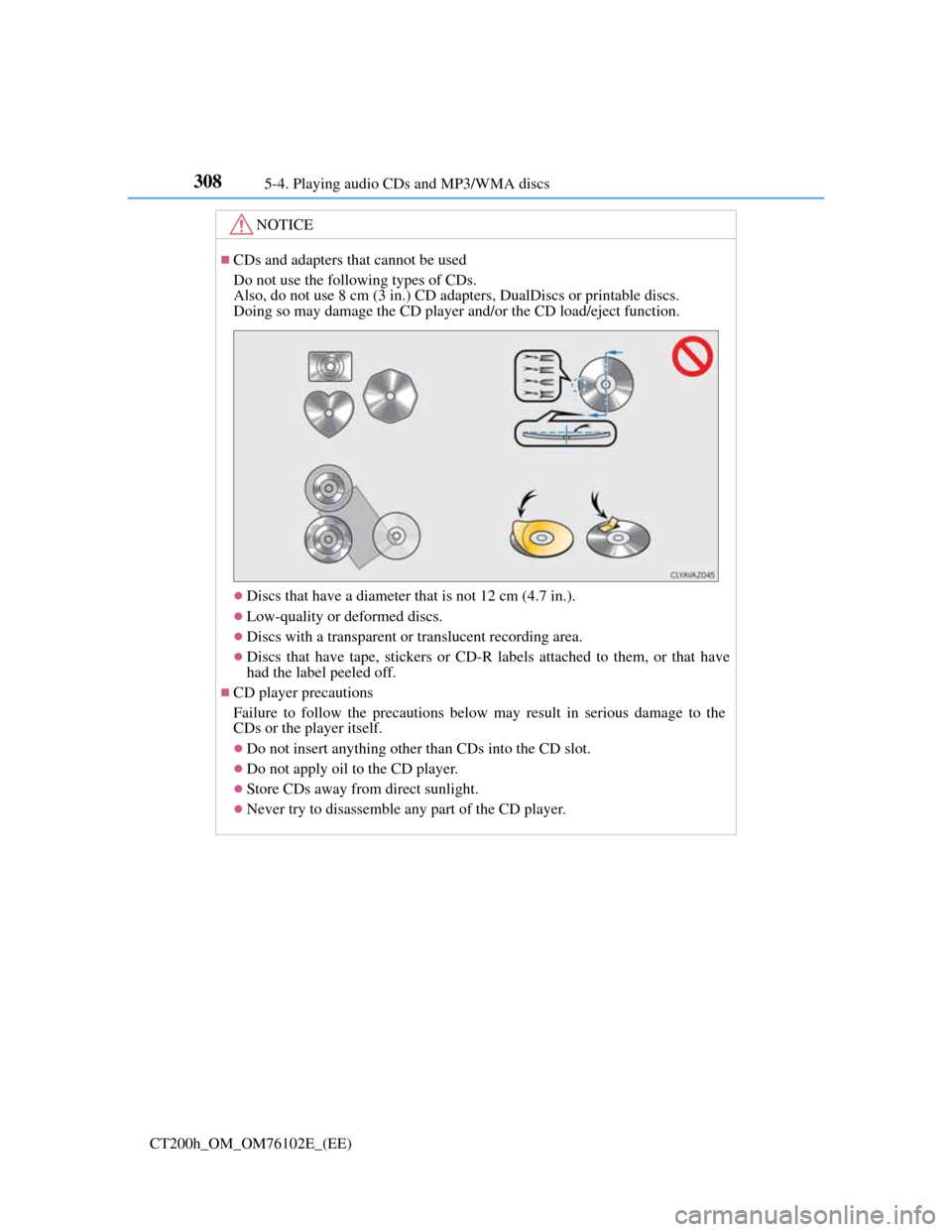
3085-4. Playing audio CDs and MP3/WMA discs
CT200h_OM_OM76102E_(EE)
NOTICE
CDs and adapters that cannot be used
Do not use the following types of CDs.
Also, do not use 8 cm (3 in.) CD adapters, DualDiscs or printable discs.
Doing so may damage the CD player and/or the CD load/eject function.
Discs that have a diameter that is not 12 cm (4.7 in.).
Low-quality or deformed discs.
Discs with a transparent or translucent recording area.
Discs that have tape, stickers or CD-R labels attached to them, or that have
had the label peeled off.
CD player precautions
Failure to follow the precautions below may result in serious damage to the
CDs or the player itself.
Do not insert anything other than CDs into the CD slot.
Do not apply oil to the CD player.
Store CDs away from direct sunlight.
Never try to disassemble any part of the CD player.
Page 390 of 688
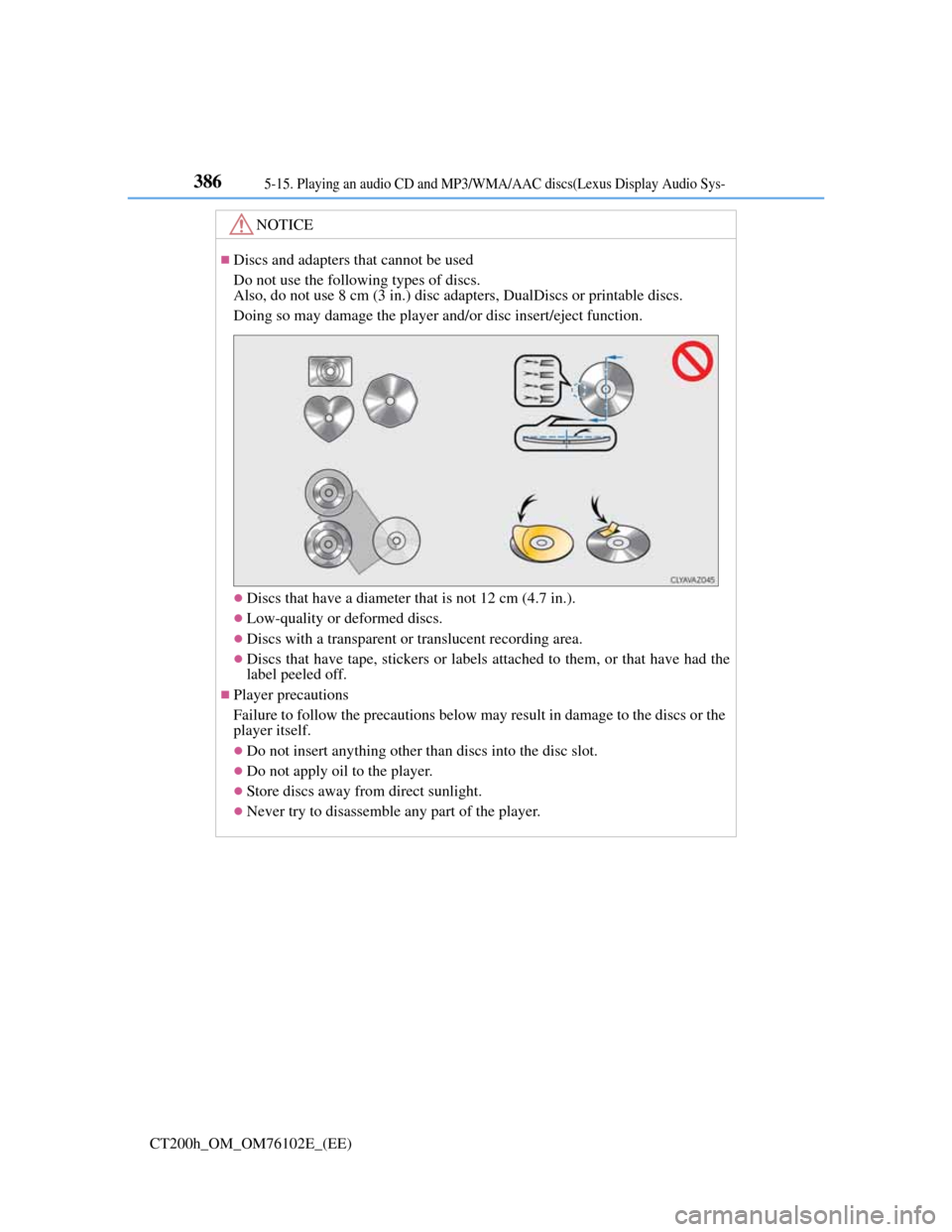
3865-15. Playing an audio CD and MP3/WMA/AAC discs(Lexus Display Audio Sys-
CT200h_OM_OM76102E_(EE)
NOTICE
Discs and adapters that cannot be used
Do not use the following types of discs.
Also, do not use 8 cm (3 in.) disc adapters, DualDiscs or printable discs.
Doing so may damage the player and/or disc insert/eject function.
Discs that have a diameter that is not 12 cm (4.7 in.).
Low-quality or deformed discs.
Discs with a transparent or translucent recording area.
Discs that have tape, stickers or labels attached to them, or that have had the
label peeled off.
Player precautions
Failure to follow the precautions below may result in damage to the discs or the
player itself.
Do not insert anything other than discs into the disc slot.
Do not apply oil to the player.
Store discs away from direct sunlight.
Never try to disassemble any part of the player.
Page 484 of 688
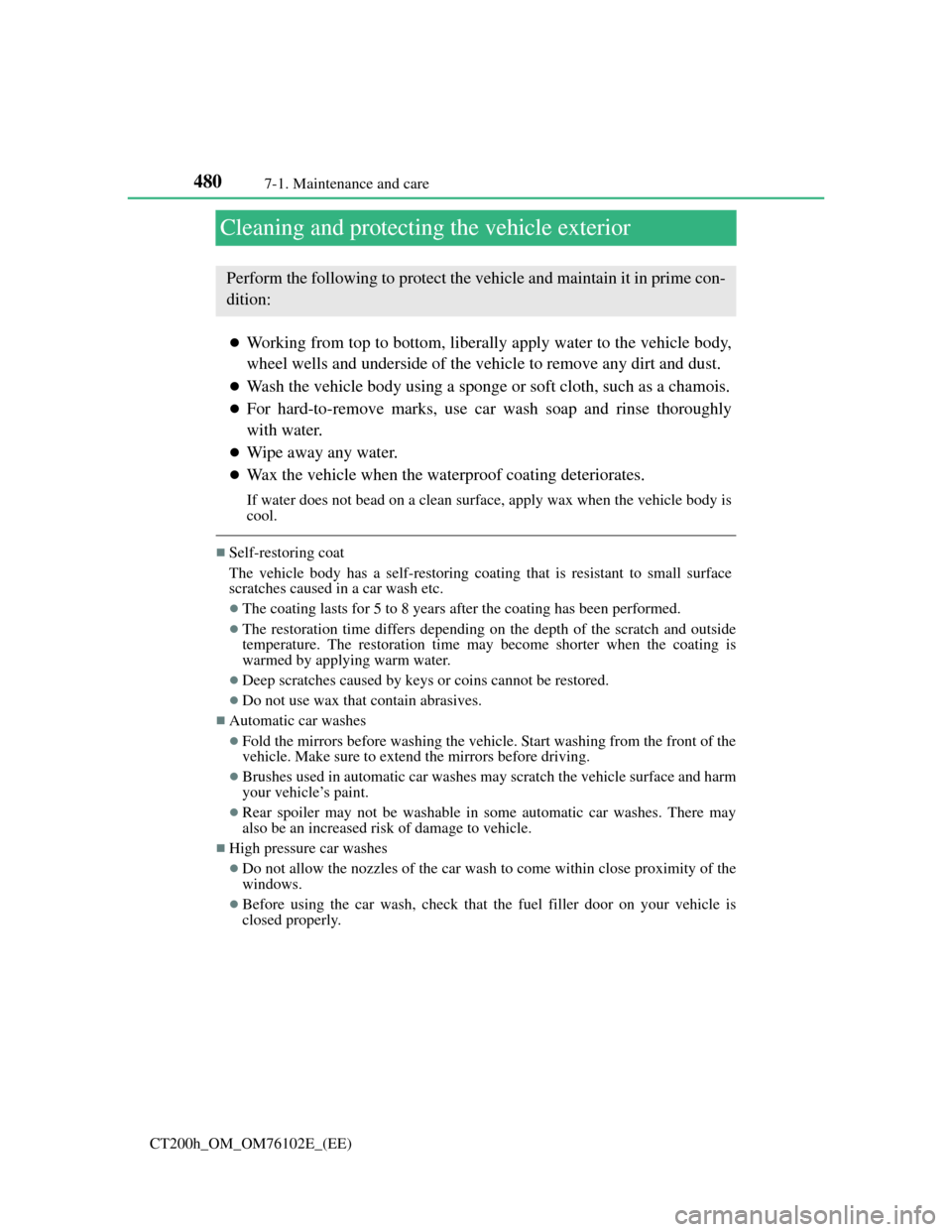
4807-1. Maintenance and care
CT200h_OM_OM76102E_(EE)
Cleaning and protecting the vehicle exterior
Working from top to bottom, liberally apply water to the vehicle body,
wheel wells and underside of the vehicle to remove any dirt and dust.
Wash the vehicle body using a sponge or soft cloth, such as a chamois.
For hard-to-remove marks, use car wash soap and rinse thoroughly
with water.
Wipe away any water.
Wax the vehicle when the waterproof coating deteriorates.
If water does not bead on a clean surface, apply wax when the vehicle body is
cool.
Self-restoring coat
The vehicle body has a self-restoring coating that is resistant to small surface
scratches caused in a car wash etc.
The coating lasts for 5 to 8 years after the coating has been performed.
The restoration time differs depending on the depth of the scratch and outside
temperature. The restoration time may become shorter when the coating is
warmed by applying warm water.
Deep scratches caused by keys or coins cannot be restored.
Do not use wax that contain abrasives.
Automatic car washes
Fold the mirrors before washing the vehicle. Start washing from the front of the
vehicle. Make sure to extend the mirrors before driving.
Brushes used in automatic car washes may scratch the vehicle surface and harm
your vehicle’s paint.
Rear spoiler may not be washable in some automatic car washes. There may
also be an increased risk of damage to vehicle.
High pressure car washes
Do not allow the nozzles of the car wash to come within close proximity of the
windows.
Before using the car wash, check that the fuel filler door on your vehicle is
closed properly.
Perform the following to protect the vehicle and maintain it in prime con-
dition: